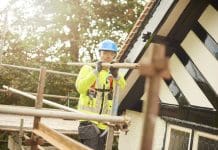The HSE provide an outline of the CDM Regulations 2015 and how they should be interpreted to ensure compliance…
On April 2nd, HSE published the new CDM 2015 Regulations and the accompanying L series guide. The guide explains what the law is seeking to achieve and what the regulations mean in practice for the various dutyholders, across all construction projects. This guide is supported by a series of industry guidance booklets, one for each dutyholder and one for workers. Written by industry groups representing the breadth of construction professionals, and hosted by CITB, their focus is to provide practical advice on implementing the new legal requirements on smaller construction projects.
Both the L Series and industry guides can be freely downloaded from HSE and CITB websites.
So….what’s new?
– Simplified structure to the regulations;
– Clients responsibilities strengthened and broadened;
– Removal of exemption for domestic clients;
– A new role of Principal Designer to co-ordinate the design stage;
– Removal of the role of CDM-C;
– Removal of notification as a trigger point for additional duties;
– Notification threshold includes worker numbers;
– Appointments threshold being where more than one contractor on a project;
– Removal of ‘competence’ requirement and replaced with ‘skills, knowledge, experience and training’ and ‘organisational capability’.
Simplified
The regulations provide a much more linear structure that represents the process of delivering a construction project from concept, through design and build to handover and future use of a structure. This approach provides greater clarity on the importance and influence that each dutyholder has on the way that construction hazard and risks are identified, reduced, controlled and managed, throughout a project.
Commercial Clients
Recognising the importance and influence a client has over the way a project is procured and delivered and the standards to which these are done, the regulations strengthen and broaden their responsibilities. The regulations encourage clients to actively lead construction projects, whilst recognising that their experience and abilities will be diverse.
The client is now responsible for making the arrangements by which the project will be managed and ensuring that those arrangements are maintained and reviewed throughout the life of the project.
Where there is or is likely to be more than one contractor working on a project, the client must appoint both a Principal Designer (PD) and a Principal Contractor (PC) at the earliest opportunity and before construction starts. The client is also responsible for taking ‘reasonable steps’ to ensure both the PD and PC comply with their duties, for providing Pre Construction Information (PCI), ensuring the construction phase plan and health and safety file are produced, and for ensuring the health and safety file is handed over to any new owner of the structure.
Domestic Clients
Although the exemption for domestic clients has been removed, the only responsibility placed upon them is to appoint the PC and PD, where there is more than one contractor. However, if this (as will be common practice) does not happen, the regulations automatically transfer the client duties to the contractor or principal contractor of a project. In recognising that some domestic clients may have already established a relationship with their designer before they go ahead with construction, the regulations allow the designer to take on the client duties where there is a written agreement between the client and designer to do so.
Principal Designer
This new role brings the function of planning, managing, monitoring and co-ordinating the design stage of the project, directly into the project team and under the control of a designer.
The PD will support the client in bringing together and providing the PCI and act as the conduit for disseminating that information to the various dutyholders who will need it at the right time. This will be an ongoing responsibility throughout the life of the project.
The PD is responsible for ensuring the designers working on the project discharge the duties placed upon them as designers throughout their appointment.
The role of the PD mirrors that of PC in the construction phase. This role is not limited to the design stage before construction starts. The PD will work together with the PC throughout the life of their appointment to ensure the health and safety implications of design aspects and any later changes are properly considered. The PD will also support the PC in drawing up the construction phase plan as well as developing the health and safety file and providing it to the client at the end of the project.
The regulations do recognise that in some projects the PD may not be contracted throughout the whole life of the project – especially when the design stage is complete and the construction phase is well advanced. If, in this situation the PD is released from the project, then the responsibility for completing the health safety file and handing it to the client at the end of the project passes to the PC.
Notification
The notification threshold for projects has changed. A project becomes notifiable where it lasts longer than 30 days AND has more than 20 workers, working simultaneously at any one point OR exceeds 500 person days.
Increasing the notification threshold will reduce the number of projects required to be notified significantly, and thus reduce the burden on business.
Notification is a stand-alone requirement and does not give rise to any additional duties.
Removal of ‘competence’
‘Competence’ is a term that has no minimum standard of compliance, is widely misunderstood, and unhelpfully applied to both individuals and organisations giving rise to unintended bureaucracy without necessarily improving the development of a competent workforce in all sectors of construction.
To address some of these issues and to make the delivery of a competent workforce clearer for dutyholders, the new regulations have disentangled ‘competence’ into its component parts of ‘skills, knowledge, training and experience (SKTE)’, and where it refers to an organisation, ‘organisational capability’.
The new regulations focus attention on the work that individuals and organisations are appointed to undertake and require that those appointed have the necessary skills, knowledge and experience to deliver that work effectively and safely – each and every day.
It’s therefore incumbent upon anybody appointing a contractor or designer (including PD and PC) to ensure they have the necessary skills, knowledge and experience, before they are appointed.
The regulations also provide flexibility for those employing and appointing site workers, by requiring that those employed or appointed either have, or are obtaining the necessary SKTE for the task in hand. By requiring contractors to provide adequate supervision for all workers under their control, the regulations allow workers to develop site skills without being put at risk or putting themselves and others at risk.
What should designers be saying to clients (domestic, inexperienced or otherwise)
A designer can take many guises from an architect, technician or technologist through to the specific designer disciplines of structural, civil, electrical and the like. Moreover, any other discipline preparing or modifying a design, or arranging or instructing another under their control to do so, is a designer. Irrespective of the role, the duties on the designer remain the same. Primarily, their first obligation will be to ensure before they start any design work that the client is aware of their obligations under CDM.
Designers’ responsibilities differ little in this respect from that conferred on them by CDM 2007. A designer should have sufficient knowledge of the client’s obligations in order to be able to assess their knowledge and advise them of their role. Advising the client of their obligations is a routine matter that will be part of any early discussions about the project.
The regulations do not specify any one method by which designers will discharge this responsibility and indeed it will be on a case by case basis.
Many designers have in the past used a standard letter format to the client and this may well continue to be a sensible approach. In the smallest of commercial projects this may prove a useful method, but it may be that verbal advice and assurance is enough. It is often helpful for a designer to have some mechanism to record that they have discussed and advised the client on this issue – but any such mechanism should minimise bureaucracy for bureaucracy’s sake.
What if the designer is not equipped to fulfil the PD role
The client appoints the PD – and in so doing has to be satisfied before that appointment takes place that the designer appointed to be PD has the necessary SKE and/or organisation capability to undertake the work in hand in a way that secures health and safety.
The relevant designer needs to be aware of their own limitations as they should not accept the appointment unless they meet that standard.
Generally, a designer will be qualified and a member of a relevant professional body, and as such can demonstrate their capabilities fairly readily in respect of the design function.
What may be more of a concern is whether the designer has sufficient health and safety knowledge or the organisational capability to undertake the work in a way that secures health and safety.
If a designer wants their health and safety skills assessed in order to assure the client that they meet the standard for appointment then they can do so by different methods. A third party assessment using an assessment body which is a member of the umbrella organisation Safety Schemes in Procurement (SSIP) (www.ssip.org.uk) is one method, but not a requirement of the law. If a designer wanted to undertake self-assessment to provide the client with assurance – then the prequalification questions in PAS 91 provides a free tool to do so.
However, the regulations do not prohibit the PD from being supported by others. Thus it would be acceptable, for a PD to ‘buy – in’ specialist support in areas such as health and safety, if the PD’s skills were still developing and to provide the organisational capability required. But, the responsibility for discharging the requirements of the PD role cannot be delegated either downward or sideways and thus the PD will always be fully responsible for the requirements placed upon them – irrespective of whether they are supported by others or not, in their discharge.
What if the designer is only appointed to undertake design (planning, building regs)
The duties on the designer are the duties of the designer irrespective of when subsequent construction takes place and by whom.
They are still required to ensure the client understands their responsibilities and to consider health and safety hazard and risk as part of their design process and through that process eliminate them. Where that is not reasonably practicable, the designer must, through subsequent design considerations, reduce or control those risks.
Additionally, the designer will need to include with the design, sufficient information about the designed structure, its construction or maintenance, that allows other designers and contractors to fulfil their duties in the future. ■
. . . . . . . . . . . . . . . . . . . . . . . . . . . . . . . . . . . . . . . . . . . . . . .
Health and Safety Executive (HSE)













